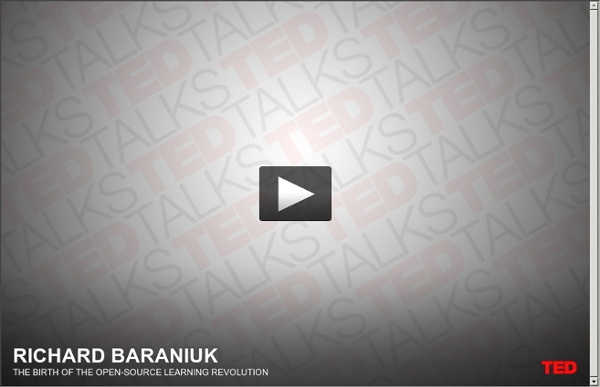



http://www.ted.com/talks/richard_baraniuk_on_open_source_learning.html
WALC2011 The active learning model is currently utilized in many undergraduate programs throughout the United States and continues to expand at the university level. Research shows that implementation of the active learning model results in a significant increase in students’ knowledge retention and improvements in student performance. Particularly impressive gains have been documented among groups of students that traditionally have been under-represented in science. The 2011 Windward School Active Learning Colloquium aims to develop the skills and knowledge necessary for school leaders to guide reform of the learning, assessment, and teaching of science at the secondary school level.
Teachers Training International – Helping you motivate, manage and engage your students One of the downsides of teaching is that in the process of educating our students about facts and figures we are also teaching our students how to think. For most teachers their initial response would be to not give this a second thought. However I wonder if this might be one of the greatest long term problems that education is facing right now. Watch the following two and a half minute talk clip and then I will explain my thoughts (the key thought happens at 2:26) Did you catch the key sentence? Let’s never forget that whatever brilliant ideas you have or hear, that the opposite may also be true.”
2010 Horizon Report Download the 2010 Horizon ReportPDF • ePub (also available in other languages) The 2010 Horizon Report is a collaboration betweenThe New Media Consortium and theEDUCAUSE Learning Initiative An EDUCAUSE Program © 2010, The New Media Consortium. Permission is granted under a Creative Commons Attribution-NonCommercial-NoDerivs license to replicate and distribute this report freely for noncommercial purposes provided that it is distributed only in its entirety. To view a copy of this license, visit creativecommons.org/licenses/by-nc-nd/3.0/ or send a letter to Creative Commons, 559 Nathan Abbott Way, Stanford, California 94305, USA. Citation Johnson, L., Levine, A., Smith, R., & Stone, S. (2010).
Continuous Partial Attention What is continuous partial attention? Continuous partial attention describes how many of us use our attention today. It is different from multi-tasking. The two are differentiated by the impulse that motivates them. When we multi-task, we are motivated by a desire to be more productive and more efficient. How to implement studio teaching? Philosophy Studio teaching is not just another kind of classroom activity. It is not a lab session, nor is it just a series of class projects. It is an approach to teaching and learning that gets students actively engaged in directing their own learning. The instructor is not the focus of the class, as in traditional classrooms. In praise of cooperation without coordination: Clay Shirky at TEDGlobal 2012 Amy Cuddy must be proud: Clay Shirky walks on stage and promptly strikes a power pose. Then he tells us of a 9-year-old Scottish girl who lives about 50 miles from here. Martha Payne started the foodblog NeverSeconds, for which she took her camera into school to document her lunches, using metrics such as “pieces of hair found in food.”
Skyline CPI A Complete How-To for Creating Curriculum Sites and Student Portfolios using Google's Tools! Note: at this time Google is currently switching from Google Docs to Google Drive. We will update this site as soon as the switch is complete. The WhatA methodology for creating and organizing online student portfolios and curriculum sharing sites throughout an entire school. Mapping GitHub – a network of collaborative coders GitHub is a large community where coders can collaborate on software development projects. People check code in and out, make edits, etc. Franck Cuny maps this community (with Gephi), based on information in thousands of user profiles. Position Statement - Quality Science Education and 21st-Century Skills Introduction Rapid changes in the world—including technological advancement, scientific innovation, increased globalization, shifting workforce demands, and pressures of economic competitiveness—are redefining the broad skill sets that students need to be adequately prepared to participate in and contribute to today's society (Levy and Murnane 2005; Stewart 2010; Wilmarth 2010). NSTA acknowledges the need for and importance of 21st-century skills within the context of science education and advocates for the science education community to support 21st-century skills consistent with best practices across a preK–16 science education system.
Sensemaking In information science the term is most often written as "sense-making." In both cases, the concept has been used to bring together insights drawn from philosophy, sociology, and cognitive science (especially social psychology). Sensemaking research is therefore often presented as an interdisciplinary research programme. Sensemaking and information systems[edit] Dervin (1983, 1992, 1996) has investigated individual sensemaking, developing theories underlying the "cognitive gap" that individuals experience when attempting to make sense of observed data. What Is an Essential Question? What is an essential question? An essential question is – well, essential: important, vital, at the heart of the matter – the essence of the issue. Think of questions in your life that fit this definition – but don’t just yet think about it like a teacher; consider the question as a thoughtful adult. What kinds of questions come to mind? What is a question that any thoughtful and intellectually-alive person ponders and should keep pondering?